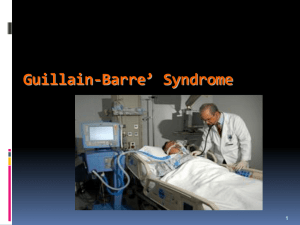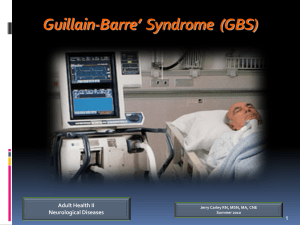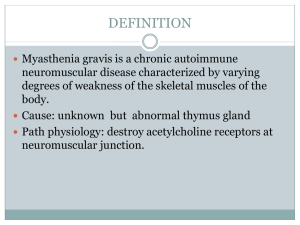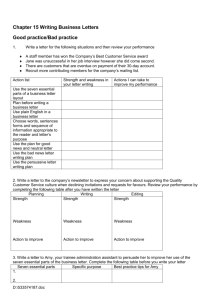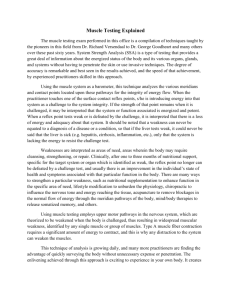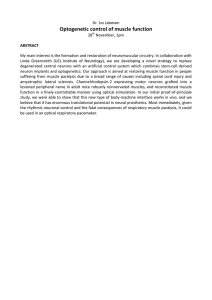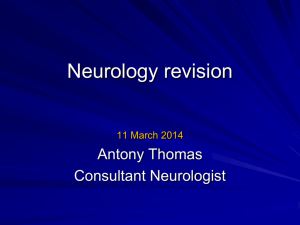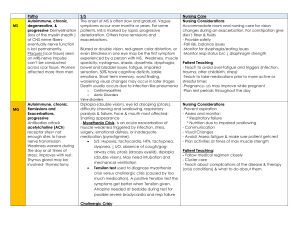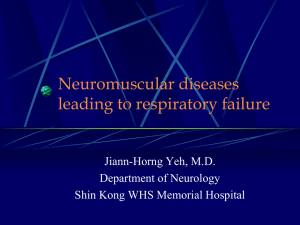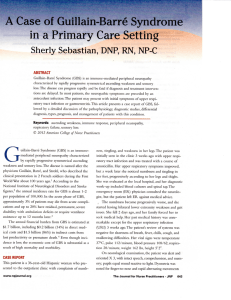Post-infectious polyneuropathy; ascending polyneuropathic paralysis An acute, rapidly progressing and potentially
advertisement
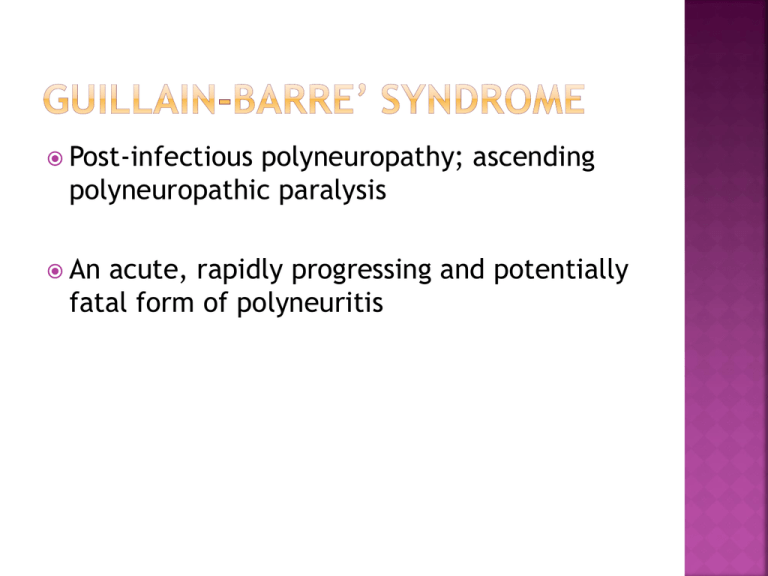
Post-infectious polyneuropathy; ascending polyneuropathic paralysis An acute, rapidly progressing and potentially fatal form of polyneuritis Acute demyelinating polyneuropathy Commonest cause of rapid-onset flaccid paralysis Occurs as an autoimmune response following a GI or respiratory infection Potentially severely debilitating disorder affecting 1-3 per 100,000 10% die from associated complications A further 10% suffer from long term neurological sequelae and physical dependence Affects the peripheral nervous system Usually develop 1 to 3 weeks after URI or GI infection Weakness of lower extremities (symmetrically) Parathesia (numbness and tingling), followed by paralysis Hypotonia and areflexia (absence of reflexes) Pain in the form of muscles cramps or hyperesthesias (worse at night). Autonomic nervous system dysfunction results from alterations in sympathetic and parasympathetic nervous systems. Results in respiratory muscle paralysis, hypotension, hypertension, bradycardia, heart block, asystole. Involvement of lower brainstem leads to facial and eye weakness Most serious is respiratory failure. How do we manage? Based on history and physical EMG and nerve conduction studies will be abnormal Ventilator support! Plasmapheresis used within the first 2 weeks of onset. If treated within the first 2 weeks, IV immunoglobin Nutritional support (TF, TPN, Diet) History History of present illness: over a two week period, begins with muscle weakness in the legs and progresses upwards. Medical history: patient may have experienced a recent infection (C jejuni, cytomegalovirus, Epstein-Barr virus, M pneumoniae); patient reports recent onset of lower extremity weakness; some increase in incidence noted with selected flu Social history: incidence greater among males from age 16 to 25 and 24 to 60 though cases have affected both genders and varied ages. Cranial and peripheral nerve integrity: evaluate cranial and peripheral nerve integrity through muscle testing and EMG/NCS (nerve conduction studies) Gait/locomotion: gait analysis for deviations Muscle strength: manual muscle testing of all four extremities; EMG analysis Range of motion: ROM may be influenced by muscular weakness Reflex integrity: reflex testing of all four extremities Ventilation/respiration: evaluate swallow and breathing as condition may progress to include involvement CSF (elevated protein) Electrodiagnostics EMG NCS Diagnosis/need for treatment: since GBS is a syndrome rather than a definitive diagnosis (at least initially), certain criteria should be considered Weakness of two or more limbs with neuropathy Decreased reflexes Short course (less than 4 weeks of weakness) Weakness should be symmetric Sensory loss may only be minimal No fever Cranial nerves become involved (eye movements, double vision, swallowing; respiratory involvement) Therapeutic exercises Functional training safe transfer skills; balance and equilibrium in all positions; and progressive ambulation; some patients may require progression on a tilt table to improve tolerance and decrease sensitivity to weight bearing neurodevelopmental sequencing is effective with progressing the geriatric patient with GBS 7 use of partial body weight support systems can be beneficial during the rehabilitation of GBS patients as they can objectively progress the patient during gait 8 proprioceptive training using devices such as the podiatron (a motorized variable pitch wobble board with handrails) is helpful with functional ability especially due to residual muscle shortening and loss of proprioception of the lower extremities 9 muscle shortening and contractures could be avoided with passive range of motion exercise and positioning is critical to achieve goal of avoiding shortening and contractures; positioning, turning programs, and mobilization are critical to offset the risks of deep vein thrombosis and decubitii. application of devices and equipment: orthotics are beneficial to prevent contractures and minimize the effect of immobilization; bedding to prevent pressure sores should be considered; compression stockings can be used since there are some patients at risk of deep vein thrombosis due to bed rest; ankle foot orthosis (AFO) is sometimes used when beginning a gait program due to residual lower extremity weakness mechanical respiration may be required in some patients with proper techniques for maintaining hygiene and providing incentive spirometry to encourage recovery transcutaneous nerve stimulation (TENS) has been used effectively for pain control in patients with GBS hydrotherapy can be a valuable part of the treatment program with the GBS patient as it encourages mobility and muscle strengthening leading the improved respiratory function in the ventilator dependent patient Hughes scale (though it lacks sensitivity to subtle change and correlates poorly to other functional scales can be used. 0 – Healthy, no signs of GBS 1 – Minor symptoms or signs; able to run 2 – Able to walk > 5 meters without assistance but unable to run 3 – Able to walk > 5 meters with assistance (human or crutch) 4 – Bed or chair bound; unable to walk 5 – Requiring assist with ventilation for at least part of the day or night
